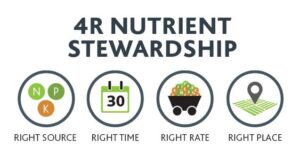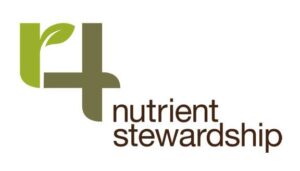
In order to attain high yielding harvests, a germinating seed in the soil needs to have several things available to it, among others:
- Sunlight and heat
- Water (not too much, not too little)
- Soil biology including organisms like worms, fungi, bacteria; and
- Balanced soil fertility that is available to the growing plant when it needs it
Of these four requirements, the final point is the one we have the most control over, better understand, and can actively amend as growers. Providing plant nutrients to the plant is not as simple as dumping a high rate of fertilizer across an entire field, as this can cause issues such as nutrient tie-up, crop injury, and is detrimental to the environment.

Proper nutrient application is guided by management practices that come together as the 4Rs of Nutrient Stewardship:
- Right Source, at the
- Right Rate,
- Right Time, and
- Right Place.
The 4R Nutrient Stewardship Program has been put into place for Ontario Ag-Retailers and Nutrient Service Providers to adhere to 4R standards to address the following goals:
- Optimize crop uptake of nutrients and minimize nutrient losses;
- Reduce eutrophication and incidence of harmful algal blooms in water bodies;
- Encourage sharing of the most up-to-date information about responsible nutrient stewardship among all interested groups; and
- Help the agricultural sector adapt to new research and technology relating to nutrient stewardship.
In the Great Lakes region that we live in, it is important to protect and keep the water that we survive on clean and free of nutrient loading. We all have a part to play in keeping our valuable resources safe for the future.
So how does using the 4Rs impact my on-farm productivity?
4R Nutrient Management is all about utilizing plant nutrients in the most efficient manner to get the best use and greatest agronomic and economic benefit from those nutrients. We’ll break it down by each of the 4Rs to better understand how you may be able to adjust practices to get the best return on your nutrient investment into your fields.
Right Source:
- Match the correct product to what best suits your operation
- Are the nutrients available for immediate uptake?
- What nutrients are already available in the soil? No benefit to applying K-Mag to soil with high Mg levels already
- Is crop safety a concern?
- Do you have manure/compost/bio-solids applied on the field?
Right Rate:
- Match the amount of fertilizer to crop nutrient uptake and removal
- Soil test! Impossible to guess the most efficient rate if you don’t know where you are to start
- What is your crop’s yield goal?
- Yield data and profitability mapping can give insights into zones of the field to best invest in, and areas where you can cut back
- Why spread enough fertilizer for 250 bus/ac of corn across the entire field if you have zones with a potential of 125 bus/ac?
Right Time:
- Match the nutrient’s availability to the crop uptake pattern
- Is it a nutrient more prone to runoff or leaching?
- Do not apply nutrients to frozen or snow covered ground!
- Do not apply nitrogen in the fall! (other than for fall planting N requirements)
- Do not apply fertilizer with a heavy rain in the immediate forecast!
- Nobody wants to see their fertilizer investment run off to the ditch or out the tile drain
Right Place:
- Match the nutrient application to the where it is physically needed: both within the soil profile and across the field as a whole
- Is the fertilizer best placed in a band in the root zone?
- Is the nutrient needed across the entire field? Or in certain areas more than others?
- Consider crop type, field topography, soil test levels, etc.
Looking at all aspects of what, why, and how we apply crop nutrients to our fields can help us identify areas to improve and prevent losses to the environment.
The 4Rs are simply a way to help make your fertilizer input dollars go farther while keeping your productivity levels up, as well as minimize loss and prevent degradation of our fresh water resources.
We can continue to improve on the great work that you as farmers are already doing!
Sylvite Agri-Services currently has 6 retail locations that are 4R Certified:

- Kent Bridge
- Blenheim
- Mitchell
- Norwich
- Silverhill
- Putnam
Feel free to get in touch to discuss the 4Rs and how you may benefit. Talking about the 4Rs and educating our customers is something we are very passionate about.
For more information on the 4Rs of Nutrient Stewardship, please visit the Fertilizer Canada website at: https://fertilizercanada.ca/our-focus/stewardship/4rs-across-canada/ontario